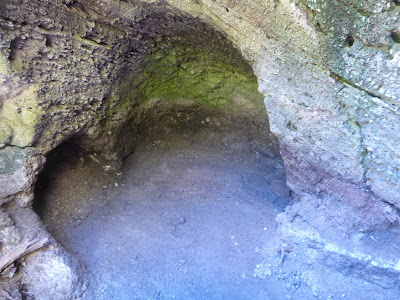An Army of One
Or at least a field team of one - For the past few days I've been doing solo digging at Smiths Island to finish up some of the remaining features that appeared in the last days of the field school and also to excavate the hearth and oven. My family flew back stateside on Sunday, so it's just me and the dirt of Smiths Island! It's both peaceful and a bit lonely digging at Oven Site on my own - tranquil and quiet enough to hint at how Bermuda would have been 300 years ago, but only a few weeks ago the same squares had happy bantering students and Mike keeping things sane - so their absence haunts the site. But the digging has been great:
The mysterious feature cut into the east side of the hearth turns out to be a second, smaller oven. It was somewhat surreal excavating by flashlight sideways. The most interesting artifact turned out to be the remains of a shoe - an intact wooden heel with a reinforcing iron heel "U" (like a tiny horseshoe) and part of the leather upper, with many small iron nails. Lots of bones, fish scales, and eggshell as well (gotta love Bermudian soil's preservation for organics!). The larger oven had lots of charcoal (duh!), brick fragments, and bones but very little in the way of datable artifacts like ceramics or glass.
The floor of the main oven was more or less flush with the floor of the house, with no features cutting into it.
This photo also shows the square shallow feature cut into the western part of the hearth floor, as well as the pronounced stone lip at the northern edge of the hearth. With this work complete, I continued to take down the smaller oven to the east (left edge in the photo above) and discovered it had a brick floor - or rather, a primitive floor made of half-bricks and brickbats, but compact and flat. Given the number of broken bricks we found in the destruction layers in the main trench, it's highly likely that the larger oven and perhaps the hearth were also brick-lined but those bricks were robbed away when the site fell into disuse.
The coolest find in the layer above the brick floor was a cast copper-alloy button with a flower design on the front - probably 17th or early 18th century. Working alone, I got through nine different contexts during a very long day excavating (until 6pm) - the only down-side is that I'm the only one left to wash all the artifacts from these contexts in the St. George's lab.
The mysterious feature cut into the east side of the hearth turns out to be a second, smaller oven. It was somewhat surreal excavating by flashlight sideways. The most interesting artifact turned out to be the remains of a shoe - an intact wooden heel with a reinforcing iron heel "U" (like a tiny horseshoe) and part of the leather upper, with many small iron nails. Lots of bones, fish scales, and eggshell as well (gotta love Bermudian soil's preservation for organics!). The larger oven had lots of charcoal (duh!), brick fragments, and bones but very little in the way of datable artifacts like ceramics or glass.
The floor of the main oven was more or less flush with the floor of the house, with no features cutting into it.
This photo also shows the square shallow feature cut into the western part of the hearth floor, as well as the pronounced stone lip at the northern edge of the hearth. With this work complete, I continued to take down the smaller oven to the east (left edge in the photo above) and discovered it had a brick floor - or rather, a primitive floor made of half-bricks and brickbats, but compact and flat. Given the number of broken bricks we found in the destruction layers in the main trench, it's highly likely that the larger oven and perhaps the hearth were also brick-lined but those bricks were robbed away when the site fell into disuse.
The coolest find in the layer above the brick floor was a cast copper-alloy button with a flower design on the front - probably 17th or early 18th century. Working alone, I got through nine different contexts during a very long day excavating (until 6pm) - the only down-side is that I'm the only one left to wash all the artifacts from these contexts in the St. George's lab.




.jpg)
Comments